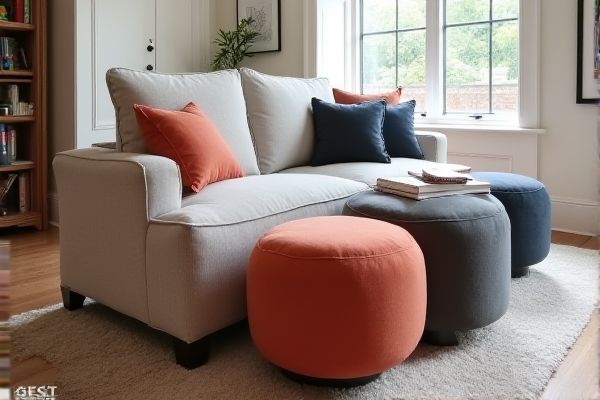
Nesting ottomans offer versatile seating and storage options by fitting neatly together, saving space while adding style and comfort to your living area. Explore the full article to discover which option best suits your needs and enhances Your home's functionality.
Table of Comparison
| Feature | Nesting Ottomans | Stackable Stools |
|---|---|---|
| Design | Soft, cushioned seating with fabric or leather covers | Solid, hard seating often made of wood, metal, or plastic |
| Space Efficiency | Nest within each other to save floor space | Stack vertically to minimize storage footprint |
| Use Cases | Comfort seating, footrest, and occasional tables | Additional seating for gatherings, events, or dining |
| Portability | Generally heavier and less easy to move | Lightweight and easy to stack or transport |
| Storage | Compact when nested; often bulkier | Highly compact when stacked; saves vertical space |
| Durability | Depends on upholstery; moderate wear resistance | Typically robust and resistant to wear |
| Price Range | Moderate to high depending on materials | Affordable to moderate |
Introduction to Nesting Ottomans and Stackable Stools
Nesting ottomans offer versatile seating and storage solutions by fitting compactly together, maximizing space efficiency in living areas. Stackable stools provide flexible, easy-to-store seating options perfect for both indoor and outdoor use, enhancing functionality in small spaces. Comparing their design and usability helps determine the best choice for optimizing room layout and utility.
Space-Saving Benefits Compared
Nesting ottomans offer versatile space-saving benefits by fitting neatly under each other, maximizing floor space without sacrificing comfort or functionality. Stackable stools, while also compact, primarily prioritize vertical storage, making them ideal for quick seating solutions in tighter areas. Your choice depends on whether you prioritize multi-purpose seating with storage or simply need efficient, stackable seating options.
Design Flexibility and Style Options
Nesting ottomans offer versatile design flexibility with their varying sizes and shapes that easily fit into different spaces while providing extra seating or storage. Stackable stools maximize space efficiency by neatly piling into compact forms, ideal for minimalist and modern interiors. Both options present diverse style choices, with nesting ottomans often featuring upholstered fabrics and patterns, and stackable stools highlighting sleek materials like wood, metal, or plastic for a contemporary aesthetic.
Functionality and Versatility
Nesting ottomans maximize space with their ability to slide neatly under one another, providing extra seating and hidden storage options that enhance room organization. Stackable stools offer compact stacking for easy storage and quick access, ideal for flexible seating arrangements in tight spaces. Your choice depends on whether you prioritize multifunctional furniture with storage (nesting ottomans) or highly portable, space-saving seating (stackable stools).
Comfort and Ergonomics
Nesting ottomans offer enhanced comfort with cushioned surfaces and ergonomic shapes designed for relaxing leg support, making them ideal for extended seating periods. Stackable stools prioritize space efficiency but often sacrifice padding and ergonomic contouring, resulting in firmer seating that may not suit long-term use. The ergonomic design of nesting ottomans supports better posture, while stackable stools are more practical for temporary seating needs.
Durability and Material Choices
Nesting ottomans often feature sturdy hardwood frames and high-density foam cushions, providing durability and long-term comfort, making them ideal for frequent use in living spaces. Stackable stools typically use metal or durable plastic materials, ensuring resistance to wear and tear while being lightweight and easy to move or store. Your choice should consider the material's strength and intended usage frequency to ensure the best durability for your needs.
Maintenance and Cleaning Considerations
Nesting ottomans typically feature fabric upholstery that requires regular vacuuming and occasional spot cleaning with upholstery cleaner to prevent stains and wear. Stackable stools, often made from wood, metal, or hard plastic, allow for easier wiping down with a damp cloth, making them more resistant to spills and dirt buildup. Both options benefit from routine dusting, but nesting ottomans demand more careful maintenance due to their softer materials and potential for fabric damage.
Best Uses for Small Spaces
Nesting ottomans provide versatile seating and storage options ideal for small spaces where maximizing utility is crucial. Stackable stools save floor space by allowing multiple seats to be stored compactly when not in use, making them perfect for tight areas or multifunctional rooms. Both options enhance small living areas by offering flexible, space-efficient furniture solutions tailored to different needs.
Price Comparison and Value
Nesting ottomans generally offer better value for your investment due to their dual function as seating and storage, often priced higher but justifying cost through versatility. Stackable stools tend to be more affordable with a focus on maximizing seating capacity in limited spaces, though they lack the added storage benefits. Considering your space and usability needs helps determine which option provides the most cost-effective solution.
Which Should You Choose?
Nesting ottomans offer versatile storage options and comfortable seating with their space-saving design, making them ideal for small living areas or multifunctional rooms. Stackable stools provide easy portability and quick seating solutions, perfect for gatherings or compact spaces where flexibility is needed. Choose nesting ottomans for added storage and comfort, while stackable stools suit those requiring lightweight, easily stored seating options.
 homyna.com
homyna.com